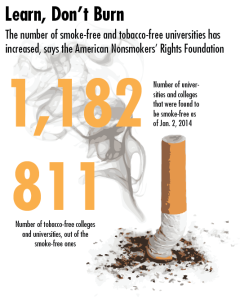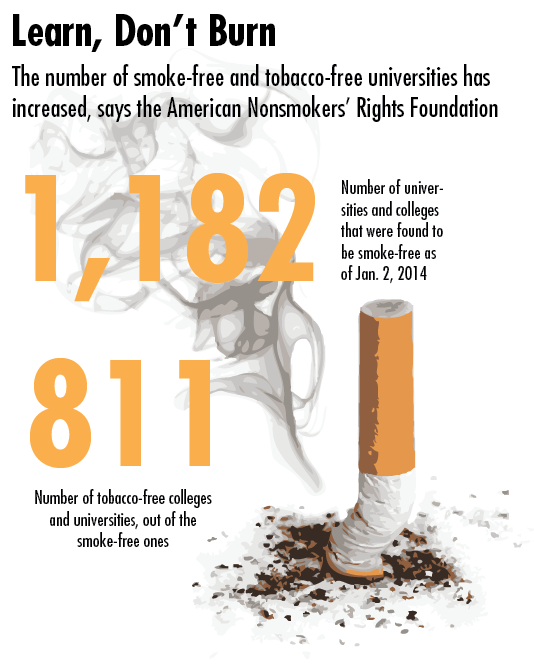
While numerous college and university campuses across the nation have become smoke-free, Stanford has only recently asked campus vendors to stop selling tobacco products on campus, a change that will be effective beginning March 1.
However, some advocates believe that the University did not take the lead in the efforts towards a smoke-free campus.
The University lagging behind
Last year, Kelly Young-Wolff, a postdoctoral research fellow of heart disease prevention at the Stanford Center for Research in Disease Prevention, along with Keith Humphreys, Stanford professor of psychiatry, started a grassroots initiative to raise awareness about smoking and tobacco-use on campus. They had hoped to get a stricter policy since 2009, a possibility that hadn’t received attention until recently.
“When it really comes to making a change in policy, it’s been pretty challenging,” Young-Wolff said.
“We’re still trying to figure out how to navigate the system to know who to approach next, who ultimately gets to make the decision and what information we should have ready to make a clear argument that this policy has important health implications and is not just symbolic,” she added.
But the team showed no signs of letting up. Though not officially sponsored, the initiative has been seeking support from other Stanford students, faculty and staff since April last year.
In the few presentations Young-Wolff gave, she said some people were still surprised by how different Stanford’s smoking policy was relative to that of other campuses.
As of Jan. 2, 2014, 1,182 colleges and universities were 100 percent smoke-free, according to a report by the American Nonsmokers’ Rights Foundation. Of these, 811 are completely tobacco-free.
More shocking to advocates and their supporters, however, was the continued sale of tobacco on campus.
In California, Stanford remains one of the last of higher-level schools in the state that continues to sell tobacco products. Currently, cigarettes can be purchased either at the Valero gas station along Serra Street or at Tresidder Express in the main Stanford campus.
This is uncommon in 2014, according to Robert Jackler, professor at the Stanford School of Medicine and researcher on the hazards of tobacco.
“No one disputes that students have the right to make a personal choice to smoke,” Jackler said. “Respecting this right of choice, the University should not adopt policies which facilitate a habit which is the leading cause of preventable death in America and shortens the life of its users by some 10 years.”
Philip Pizzo, who led the School of Medicine in going smoke-free in 2007 when he was dean, said he would “very much like to see Stanford University be a completely smoke-free campus.”
“I recognize that it’s a decision that needs other champions, be they students or faculty or leaders, and ultimately the leadership of the University as well,” Pizzo said.
Pizzo also noted one difference between the medical center and the University.
“Health is clearly the purpose and mission of the medical school and the medical center,” Pizzo said. “There was an acknowledgement by the University leadership that by becoming smoke free, we were doing things consistent with our mission. The rest of the University is around the University and research but not health other than through the BeWell program.”
Attempted student initiatives
Not including the recent effort led by Young-Wolff and Humphreys, two different student-led efforts have pushed for a smoke-free campus in the past and failed.
Jamie Tam ’10 spearheaded one of the smoke-free Stanford campaigns when she was president of Stanford Colleges Against Cancer (SCAC) between 2006 and 2010.
“It’s surprising that Stanford has not been so progressive on matters of health,” Tam said.
In 2009, Tam and other members of SCAC released a petition asking for a stricter smoke-free policy that would ban the sale of tobacco on campus, push for smoking cessation programs for students and prohibit smoking on campus, except in a few sufficiently remote places.
It was the last of these three components that drew major opposition.
“There was incredible misunderstanding of what we were asking people to support,” said Tam. “Many people assumed that the petition called for a complete ban on smoking, but unlike most smoke-free campus policies, the petition’s proposal allowed for limited exemptions.”
Tam recognized Stanford as a complex case because of the campus’s large contiguous area, which raised questions about the extent of the policy.
“If you’re a member of the faculty or staff, you could still walk somewhere and smoke but it would be far enough away from the main parts of campus,” Tam said.
Because most attention was paid to the smoke-free component–leaving the others calling for cessation programs and a ban on tobacco sales virtually ignored–the entire proposal fell through. It may be that this petition with exceptions was confused with an earlier petition released by the same group that called for a complete ban on smoking.
“In a University which highly values academic freedom, prohibitionistic rhetoric seems out of place and students feared a paternalistic slippery slope,” Jackler said.
The group was forced to withdraw petition and decided against bringing their proposal to the Faculty Senate. Because many of the group’s leaders graduated, their advocacy work was left untouched– until now.
There are signs that the new initiative may have more traction this time. Unlike in 2010, students can find cessation programs at the Health Promotion Program.
Cigarettes still on campus
At Tresidder Express, one of the two tobacco-sellers on campus, cigarettes are kept behind the counter.
“When you walk in, you can’t even see them,” Young-Wolff said. “I think that’s already a sign that it would be best to just stop selling them.”
Ultimately, President John Hennessy would sign off on a policy that would make Stanford smoke- and tobacco-free, but only after deeming the change relevant and appropriate.
So far, there have not been concerns raised to the President’s attention regarding the existing smoking and tobacco-use policy in the administrative guide, said Jeffrey Wachtel ’79, senior assistant to the President.
“As far as changing the policy–anything that affected the entire campus–there are many different constituencies that we’d want to consult before moving forward just to make sure we’ve surfaced all the issues,” Wachtel said.
Advocates for a smoke-free and tobacco-free campus are confident that there is enough interest to see the policy passed.
“The real question is how long of a process this is going to take,” Young-Wolff said.
Contact Vanessa Ochavillo at vochavillo ‘at’ stanford ‘dot’ edu.
